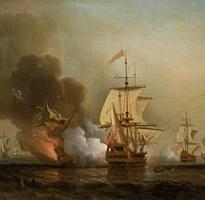 On Monday, the Woods Hole Oceanographic Institution (WHOI) announced in a press release, that they “recently obtained authorization by Maritime Archaeology Consultants (MAC), Switzerland AG, and the Colombian government to release new details from the successful search for the three-century-old San José —a 62-gun, three-masted Spanish galleon ship that sank with a cargo believed to be worth billions of dollars. The ship, which is often called the “holy grail of shipwrecks,” went down with a treasure of gold, silver, and emeralds in 1708 during a battle with British ships in the War of Spanish Succession.”
On Monday, the Woods Hole Oceanographic Institution (WHOI) announced in a press release, that they “recently obtained authorization by Maritime Archaeology Consultants (MAC), Switzerland AG, and the Colombian government to release new details from the successful search for the three-century-old San José —a 62-gun, three-masted Spanish galleon ship that sank with a cargo believed to be worth billions of dollars. The ship, which is often called the “holy grail of shipwrecks,” went down with a treasure of gold, silver, and emeralds in 1708 during a battle with British ships in the War of Spanish Succession.”
The discovery was made over two years ago as announced by Colombia’s President Juan Manuel Santos. At the time little information on the discovery was made available. The recent press release by WHOI provides many missing details, including the use of an Underwater Autonomous Robot (AUV), the REMUS 6000.
“The legendary wreck was discovered off the coast of Cartagena, Colombia, on Nov. 27, 2015, by a team of international scientists and engineers during an expedition aboard the Colombian Navy research ship ARC Malpelo led by MAC’s Chief Project Archaeologist Roger Dooley. It was found more than 600 meters below the surface during a search initiated by MAC and approved by The Colombian Ministry of Culture. The search was supervised by Instituto Colombiano de Antropología e Historia (ICANH) and Dirección General Marítima (DIMAR).
“In order to ensure a successful search, we retained the services of Woods Hole Oceanographic Institution, which has an extensive and recognized expertise in deepwater exploration,” said Dooley. “This partnership was key to the discovery of the San Jose.”
WHOI played a crucial role in both the search and discovery of the final resting place of the San José, which had remained a great mystery to marine archeologists, historians, governments, and treasure hunters for decades. Specifically, the institution provided and operated an autonomous underwater vehicle called REMUS 6000 to survey an area off Colombia’s Barú Peninsula.
“The REMUS 6000 was the ideal tool for the job since it’s capable of conducting long-duration missions over wide areas,” said WHOI engineer and expedition leader Mike Purcell.
The REMUS 6000 was also used in 2011 to find the wreckage of Air France 447 which crashed off the coast of Brazil in 2009. In 2010, the REMUS 6000 was used to map and photograph the Titanic wreck site.
The REMUS 6000 was designed under a cooperative program involving the Naval Oceanographic Office, the Office of Naval Research, and the Woods Hole Oceanographic Institution (WHOI) in support of deep-water autonomous operations.
The WHOI statement goes on to say,”the San José discovery carries considerable cultural and historical significance for the Colombian government and people because of the ship’s treasure of cultural and historical artifacts and the clues they may provide about Europe’s economic, social, and political climate in the early 18th century. The Colombian Government plans to build a museum and world-class conservation laboratory to preserve and publicly display the wreck’s contents, including cannons, ceramics, and other artifacts.”
Thanks to Phil Leon for contributing to this post.

Any idea what they are going to do with the gold,
silver and emeralds?
First they have to retrieve the gold, silver, and emeralds. All indications are that several countries including Spain and Peru may contest ownership of the cargo. My guess is that the lawyers will be as busy as the salvors.